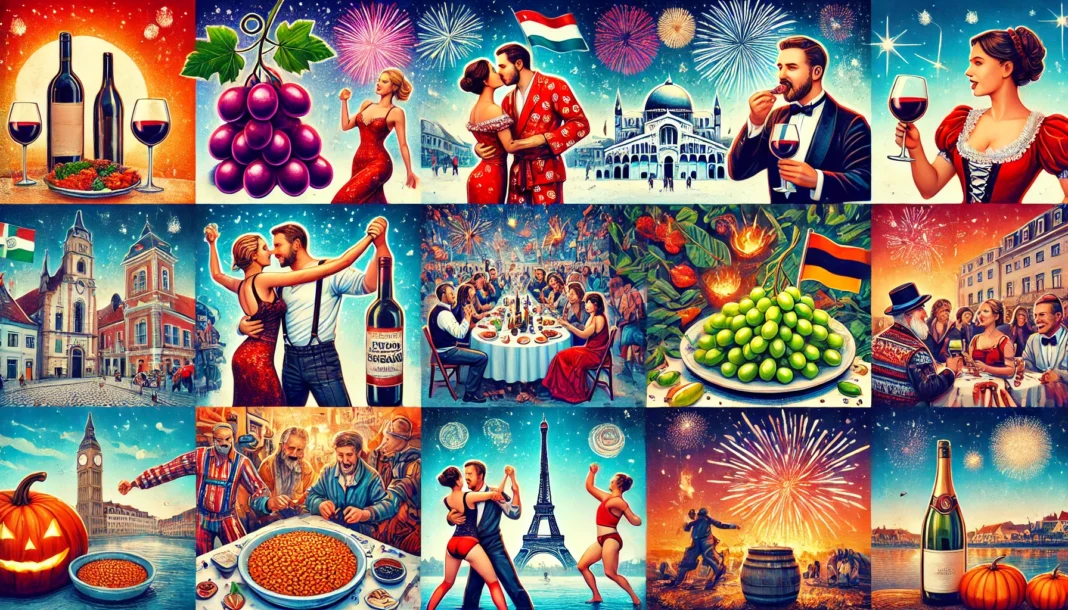Europe’s Diverse New Year’s Celebration. Across Europe, New Year’s Eve is celebrated with a dazzling variety of customs, each deeply rooted in the culture and history of its country. From Spain’s grape-eating race to Austria’s midnight waltz, these traditions showcase the unique ways Europeans welcome a fresh start while bidding farewell to the old year.
Spain: The Race for Grapes
In Spain, New Year’s Eve is a race against time, with a culinary twist. As the clock strikes midnight, Spaniards strive to eat 12 grapes—one for each chime of the clock. This century-old tradition is said to bring good fortune for every month of the coming year. The practice originated in the late 19th century when a surplus of grapes inspired winemakers to promote the fruit as a symbol of luck. Today, the custom is a spirited—and sometimes hilarious—race to keep up with the clock’s chimes.
Hungary: Lentils for Prosperity
For Hungarians, the new year begins with a focus on wealth and abundance, symbolized by lentils. On January 1st, families gather to enjoy lentil soup or stew, believing that the round shape of the legumes resembles coins and promises financial prosperity. This hearty dish is often accompanied by lively conversation about the hopes and dreams for the year ahead, making it a communal and meaningful way to start anew.
Italy: Luck in Red
In Italy, New Year’s Eve is steeped in sartorial superstition. Italians wear red underwear as a talisman for good luck, love, and success in the coming year. This tradition dates back to ancient Rome, where red was associated with fertility and health. Today, red underwear has become a festive staple, often exchanged as gifts during the holiday season. It’s a playful and colorful way to welcome good fortune.
Portugal: Good Fortune in Blue
Across the border in Portugal, the lucky color of the evening is blue. Portuguese revelers believe that wearing blue underwear on New Year’s Eve invites serenity, harmony, and protection from harm. Additionally, the Portuguese celebrate with a noisy ritual at midnight, banging pots and pans with spoons to drive away evil spirits. This lively tradition ensures a fresh and positive start to the new year.
Denmark: Smashing Plates for Popularity
In Denmark, New Year’s Eve celebrations are as loud as they are symbolic. Throughout the year, Danes save old plates, only to smash them against the doors of friends and family at midnight. The more broken crockery on your doorstep, the more popular you are considered. This unique custom is not just a test of one’s popularity but also a boisterous way to express goodwill and affection.
Germany: Fortune-Telling with Wax
Germany’s New Year’s Eve traditions focus on glimpsing the future. An age-old custom, now adapted for safety, involves melting wax (previously lead) and pouring it into cold water. The shapes formed are then interpreted as predictions for the coming year—hearts for love, boats for travel, and so on. This tradition offers a reflective moment amidst the festivities, inviting participants to ponder what lies ahead.
Czech Republic: Apples as Omens
In the Czech Republic, New Year’s fortunes are told with apples. By slicing an apple in half, celebrants examine the shape of the core. If the seeds form a star, it’s a sign of good luck and prosperity; a cross shape, however, is seen as a bad omen. This simple yet meaningful tradition connects Czechs to the natural world and its symbols of fortune.
Scotland: The First Foot of Luck
In Scotland, New Year’s Eve is synonymous with Hogmanay, a festival rich in tradition. One of its most cherished customs is “first-footing,” where the first person to enter a home after midnight is believed to bring good fortune. This visitor often carries symbolic gifts such as coal (for warmth), shortbread (for sustenance), or whiskey (for cheer). This tradition reflects Scotland’s spirit of hospitality and community.
Austria: Waltzing into the New Year
Elegance and grace define Austria’s New Year’s Eve celebrations. In Vienna, couples take to the streets and ballrooms to waltz into the new year. The sound of Johann Strauss’s “Blue Danube” fills the air as Austrians mark the midnight hour with music and movement. This tradition, steeped in cultural pride, embodies the nation’s appreciation for classical music and dance.
A Celebration of Diversity
These traditions highlight Europe’s rich cultural tapestry, where each country welcomes the new year in its own distinctive way. Whether it’s smashing plates in Denmark, eating grapes in Spain, or waltzing in Austria, these customs offer a window into the values and histories of their people.
While the traditions may vary, the sentiment is universal: a shared hope for luck, joy, and prosperity in the year to come. As midnight strikes, Europeans come together in celebration, proving that the best way to greet the future is with a blend of optimism, creativity, and time-honored traditions.
Citations:
[1] https://visitukraine.today/blog/3140/how-europe-celebrates-the-new-year-the-most-interesting-traditions-from-different-countries
[2] https://xpat.gr/european-new-years-eve-traditions-for-good-luck/
[3] https://aroundtheworldstories.com/2017/12/bringing-europe-new-years-eve/
[4] https://www.euronews.com/my-europe/2024/12/30/how-does-europe-ring-in-the-new-year-euronews-staff-tell-us-how-their-countries-celebrate
[5] https://www.outlooktraveller.com/destinations/international/unique-new-years-eve-traditions-across-the-world
[6] https://www.glamour.com/story/new-years-eve-day-traditions
[7] https://n26.com/en-eu/blog/new-year-traditions-in-europe
[8] https://europeisnotdead.com/european-new-year-traditions/
[9] https://www.c-and-a.com/eu/en/shop/new-years-eve












